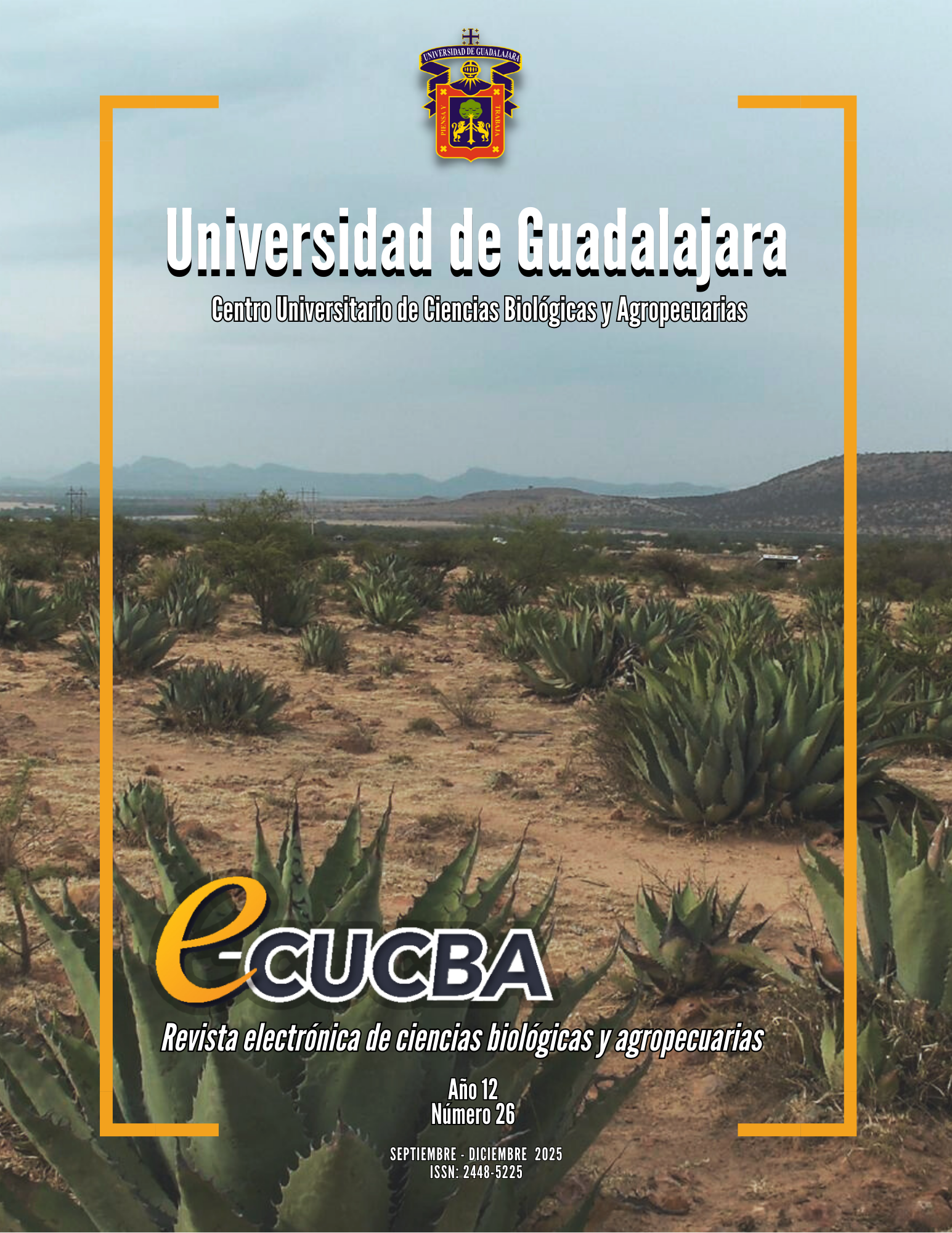Relaciones peligrosas: el estrés oxidativo y la neuroinflamación
Dangerous Relationships: Oxidative Stress and Neuroinflammation
DOI:
https://doi.org/10.32870/e-cucba.vi26.396Palabras clave:
Neurodegeneración, células gliales, radicales libre, citocinasResumen
El estrés oxidativo y la neuroinflamación son procesos biológicos complejos que contribuyen al desarrollo de enfermedades neurodegenerativas, las cuales pueden desarrollarse de forma silenciosa durante años antes de que se manifiesten síntomas evidentes. El estrés oxidativo se produce cuando la generación de radicales libres, como las especies reactivas de oxígeno (ERO), supera la capacidad antioxidante del organismo. Durante el metabolismo celular, particularmente durante la respiración y la síntesis de ATP a nivel mitocondrial, se generan continuamente radicales libres, lo que hace al cerebro especialmente vulnerable al estrés oxidativo debido a su alta demanda energética.
Por su parte, la neuroinflamación es una respuesta inmunitaria que, en un inicio, resulta adaptativa e intenta restablecer la homeostasis cerebral; sin embargo, su persistencia crónica termina por volverse perjudicial y puede causar daño neuronal. Las células gliales, como la microglía y los astrocitos, desempeñan un papel fundamental en este proceso al producir mediadores inflamatorios. La activación prolongada de estas células desencadena ciclos de estrés oxidativo y neuroinflamación que se retroalimentan y amplifican mutuamente, favoreciendo el daño tisular y la neurodegeneración.
Por lo tanto, la investigación actual en neurociencias explora alternativas terapéuticas, que incluyen compuestos naturales o sintéticos con propiedades antioxidantes o antiinflamatorias, para prevenir o mitigar el daño y disminuir la progresión de la neurodegeneración.
Citas
Bernaus, A., Blanco, S., y Sevilla, A. (2020). Glia Crosstalk in Neuroinflammatory Diseases.Frontiers in Cellular Neuroscience 14:209. https://doi.org/10.3389/fncel.2020.00209
Correia, B., Fernandes, J., Botica, M., Ferreira, C., y Quintas, A. (2022). Novel Psychoactive Substances: The Razor's Edge between Therapeutical Potential and Psychoactive Recreational Misuse. Medicines (Basel) 9:19. https://doi.org/10.3390/medicines9030019.
de Fraga, L., Tassinari, I., Jantsch, J., Guedes, R., y Bambini-Junior, V. (2021). A Picture is Worth a Thousand Words: The Use of Microscopy for Imaging Neuroinflammation. Clinical Experimental Immunology 206:325. https://doi.org/10.1111/cei.13669.
Fan, Y.-Y., y Huo, J. (2021). A1/A2 Astrocytes In Central Nervous System Injuries and Diseases: Angels Or Devils? Neurochemistry International, 148: 105080. https://doi.org/10.1016/j.neuint.2021.105080.
Gao, C., Jiang, J., Tan, Y., y Chen, S. (2023), Microglia in Neurodegenerative Diseases: Mechanism and Potential Therapeutic Targets. Signal Transduction and Targeted Therapy 8:359. https://doi.org/10.1038/s41392-023-01588-0.
Halliwell, B. (2022). Reactive Oxygen Species (ROS), Oxygen Radicals and Antioxidants: Where are We Now, Where is the Field Going and Where Should We Go? Biochemical and Biophysical Research Communications 633:17. https://doi.org/10.1016/j.bbrc.2022.08.098.
Han, V. X., Patel, S., Jones, H. F., Nielsen, T.C., Mohammad, S.S., Hofer, M. J., Gold, W., Brilot, F., Lain, S. J., Nassar, N., y Dale, R. C. (2021), Maternal acute and chronic inflammation in pregnancy is associated with common neurodevelopmental disorders: a systematic review. Translational Psychiatry. 11(1):71. https://doi.org/10.1038/s41398-021-01198-w.
Jomova, K., Raptova, R., Alomar, S., Alwasel, S., Nepovimova, E., Kuca, K., y Valko, M. (20239. Reactive Oxygen Species, Toxicity, Oxidative Stress, and Antioxidants: Chronic Diseases and Aging. Archives of Toxicology 97:2499. https://doi.org/10.1007/s00204-023-03562-9.
Krishnamurthy, H.K., Pereira, M., Rajavelu, I., Jayaraman, V., Krishna, K., Wang, T., Bei, K., y Rajasekaran, J.J. Oxidative stress: fundamentals and advances in quantification techniques. Frontiers in Chemistry 12:1470458. https://doi: 10.3389/fchem.2024.1470458.
Lawrence, J., Schardien, K., Wigdahl, B., y Nonnemacher, M. (2023). Roles of Neuropathology-associated Reactive Astrocytes: A Systematic Review. Acta Neuropathologica Communications 11:42. https://doi.org/10.1186/s40478-023-01526-9.
Li, K., Geng, Y., Lin, B., y Xi, Z. (2023). Molecular Mechanisms Underlying Mitochondrial Damage, Endoplasmic Reticulum Stress, And Oxidative Stress Induced by Environmental Pollutants. Toxicology Research (Camb) 12:1014. https://doi.org/10.1093/toxres/tfad094.
Liddelow, S., Guttenplan, K., Clarke, L., Bennett, F., Bohlen, C., Schirmer, L., et al. Neurotoxic Reactive Astrocytes Are Induced by Activated Microglia. Nature 541:481. https://doi.org/10.1038/nature21029.
Loh, J., Mak, W., Tan, L., Ng, C., Chan, H, Yeow, S., Foo, J., Ong, Y., How, C., y Khaw, K. (2024). Microbiota-gut-brain Axis and Its Therapeutic Applications in Neurodegenerative Diseases. Signal Transduction and Targeted Therapy 9:37. https://doi.org/10.1038/s41392-024-01743-1.
Lomeli-Lepe A.K., Castañeda-Cabral J.L., Ureña-Guerrero M.E., Gudiño-Cabrera G., y López-Pérez S.J. (2024). Bee Venom Reduces Early Inflammation and Oxidative Stress Associated with Lipopolysaccharide-induced Alpha-synuclein in the Substantia Nigra-striatum Axis. Cell Biochemistry and Biophysics 83:1185. https://doi.org/10.1007/s12013-024-01552-x
Millichap, L., Damiani, E., Tiano, L., y Hargreaves, I. (2021). Targetable Pathways for Alleviating Mitochondrial Dysfunction in Neurodegeneration of Metabolic and Non-Metabolic Diseases. International Journal of Molecular Science 22:11444. https://doi.org/10.3390/ijms222111444.
Mohammad, Z., Yudin, S., Goldberg, B., Serra, K., Klegeris, A. (2024). Exploring Neuroglial Signaling: Diversity of Molecules Implicated in Microglia-To-Astrocyte Neuroimmune Communication. Reviews in Neuroscience 36:917. https://doi.org/10.1515/revneuro-2024-0081
Ruelas-Montes C.A. (2024) Efectos del extracto de Hibiscus sabdariffa sobre los niveles de TNF-α, IL-1β e IL-6 en la corteza prefrontal y el hipocampo de ratas macho con hiperglucemia. Tesis de Licenciatura, Universidad de Guadalajara.
Santiago, J., Karthikeyan, M., Lackey, M., Villavicencio, D., y Potashkin, J. (2023). Diabetes: A Tipping Point in Neurodegenerative Diseases. Trends in Molecular Medicine 29:1029. https://doi.org/10.1016/j.molmed.2023.09.005.
Watts, M., Pocock, R., y Claudianos, C. (2018). Brain Energy and Oxygen Metabolism: Emerging Role in Normal Function and Disease. Frontiers in Molecular Neuroscience 11:216. https://doi.org/10.3389/fnmol.2018.00216.
Xu, X., Pang, Y., y Fan, X. Mitochondria in oxidative stress, inflammation and aging: from mechanisms to therapeutic advances. Signal Transduction and Targeted Therapy, 10:190. https://doi.org/10.1038/s41392-025-02253-4.
Zhang, Z., Zhou, H., y Zhou, J. (2021). Neuritin Inhibits Astrogliosis to Ameliorate Diabetic Cognitive Dysfunction. Journal of Molecular Endocrinology, 66:259. https://doi.org/10.1530/JME-20-0321.
Zhao, J., Zhou, Y., Zhou, C., Zhan, K., Yang, M., Wen, M., y Zhu, L. (2025). Revisiting The Critical Roles of Reactive Microglia in Traumatic Brain Injury. International Journal of Surgery 111:3942. https://doi.org/10.1097/JS9.0000000000002420.
Descargas
Publicado
Cómo citar
Número
Sección
Licencia
Derechos de autor 2025 Silvia Josefina López Pérez, Alma Karen Lomeli Lepe, José Luis Castañeda Cabral, Mónica Elisa Ureña Guerrero

Esta obra está bajo una licencia internacional Creative Commons Atribución-NoComercial-SinDerivadas 4.0.






